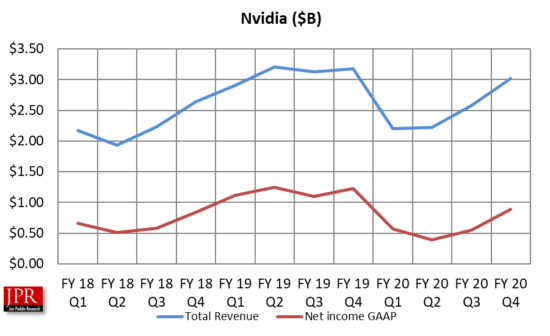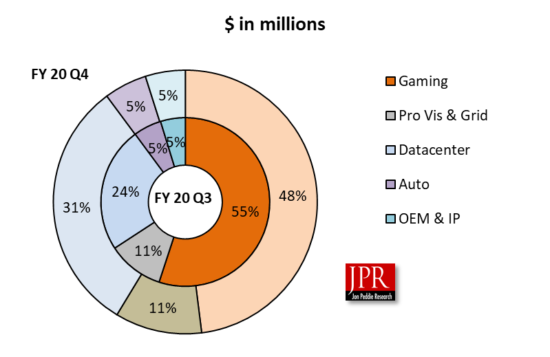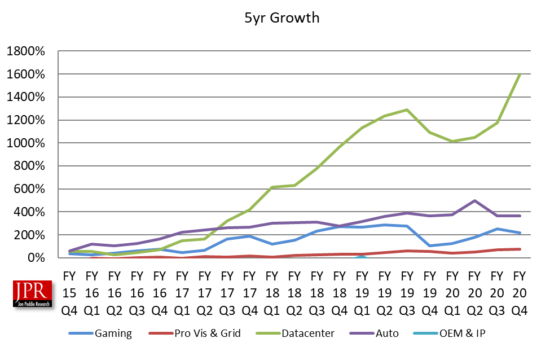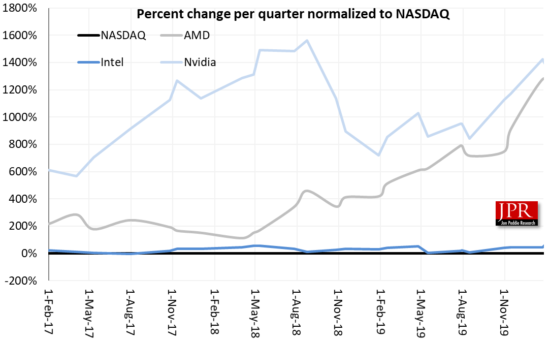Nvidia reports $3.1 billion in sales, $950 million profit, up 6% from last quarter. The real message is that Nvidia is successfully pivoting to the data center.

Nvidia reported revenue from all platforms up for the quarter and beat Wall Street’s expectations.
The company’s GPU business revenue was $2.7 billion, up 8% from last quarter, and up 40% from last year. The quarter was the first increase in year-over-year sales since Q3’18.
“Adoption of Nvidia accelerated computing drove excellent results, with record data center revenue,” said Jensen Huang, founder and CEO of Nvidia. “Our initiatives are achieving great success. Nvidia RTX ray tracing is reinventing computer graphics, driving powerful adoption across gaming, VR and design markets, while opening new opportunities in rendering and cloud gaming. Nvidia AI is enabling breakthroughs in language understanding, conversational AI, and recommendation engines—the core algorithms that power the internet today. And new Nvidia computing applications in 5G, genomics, robotics and autonomous vehicles enable us to continue important work that has great impact. We are well positioned for the greatest technology trends of our time,” he said.
The quarter’s results
GPU business revenue was $3.6 billion, up 39% sequentially.
Tegra processor business revenue—which includes automotive, SOC modules for gaming platforms, and embedded edge AI platforms—was $331 million, up 47% from a year ago and down 26% sequentially.
Gaming revenue was $1.5 billion, up 56% from a year ago and down 10% sequentially.
Professional Visualization revenue was $331 million, up 13% from a year earlier and up 2% sequentially. The year-on-year and sequential growth reflects strength across mobile workstation products.
Data Center revenue was $968 million, up 43% from a year ago and up 33% sequentially. The year-on-year decline reflects lower enterprise revenue due to a different mix of products including lower DGX sales, partially offset by an increase in hyperscale demand. The sequential increase was driven by hyperscale demand.
Automotive revenue was $163 million, flat from a year earlier and up 1% sequentially. The year-on-year decrease reflects lower revenue from legacy infotainment modules and autonomous vehicle solutions, partially offset by growth in AI cockpit solutions. The sequential decrease reflects a large non-recurring development services agreement closed in the prior quarter.
OEM and Other revenue was $152 million, up 31% from a year ago and up 6% sequentially. The sequential increase was primarily due to growth in entry-level GPUs for notebook PCs.
GAAP gross margin for the quarter was 65%, up 940 basis points from a year earlier and up 130 basis points sequentially. The year-on-year and sequential increases are primarily driven by improved margins on GeForce GPUs for gaming reflecting the sale of previously written-off components and lower component

During the fourth quarter, the company announced that Nvidia will power Tencent Games’ START cloud gaming service, which began testing earlier this year. START gives gamers access to AAA games.
- The company grew momentum for ray tracing with the launch of such RTX-enabled games as Deliver Us The Moon, Wolfenstein: Youngblood, and Bright Memory.
- Brought its GeForce NOW cloud gaming service out of beta, which the company claims opens up PC gaming to hundreds of millions of consumers who can now add a virtual GeForce graphics AIB to their device and play games they own, as well as free-to-play games.
- Brought its number of gaming laptops to 125 models, including the world’s first 14-inch GeForce RTX laptop, the ASUS ROG Zephyrus G14.
- Continued to build G-SYNC momentum at CES, with the launch of the ASUS ROG Swift 360, fast monitor, with a 360-Hz refresh rate; and with LG adopting G-SYNC in its new lineup of OLED TVs.
- Introduced RTX capabilities to Autodesk’s Maya 2020, Dassault’s Catia 2020, and Siemens Ray-Trace Studio with the release of a new Nvidia Quadro Driver and Nvidia Studio Driver.
- Expanded the reach of RTX technology into Chaos Group’s V-Ray, Autodesk’s Arnold and Blender’s Cycles, enabling designers to create complex 3D visuals, accurate reflections, and more.
- Announced that Alibaba’s and Baidu’s recommendation engines run on Nvidia AI, boosting inference by orders of magnitude beyond CPUs.
- And, joined forces with AWS, using Nvidia T4 Tensor Core GPUs to power AWS Outposts, bringing Amazon EC2.
Outlook
Nvidia says the ultimate effect of the coronavirus is difficult to estimate. The company said it has reduced its revenue outlook for the first quarter of fiscal 2021 by $100 million to account for the potential impact. Revenue is expected to be $3 billion, plus or minus 2% and non-GAAP gross margins are expected to be 65% and 65.4%, plus or minus 50 basis points.
What do we think?
This was the first quarter in the company’s history that gaming fell below 50% of its revenue.
Datacenter sales jumped, which Jensen Huang attributed to AI, saying it was due to recommendation AI and production AI-inference with 4× growth and 500,000 tensor downloads. Public cloud and vertical industries, startups have been developing AI in the cloud. The company has seen success in verticals—logistics, retail warehousing, large companies like UPS and Walmart, and Edge-AI which need low-latency inference and response time.

Pro Viz was the second-highest performer quarter-to-quarter, and gaming sales was the second-highest contributor for the quarter. Nvidia is running well and showing excellent results in a very shaky economy with a supply chain threatened by a pandemic.

The numeric values are shown in the following table.

GPU includes GPU revenue in datacenter, GeForce, Quadro, Tesla, and OEM. Gaming includes GeForce DT/NB, Switch, Other like GeForce Now, G-SYNC; Nvidia includes its Nintendo (Switch) business in with its gaming revenue as well.
Nvidia continues to enjoy a high P/E ratio (37.3 on 13 Feb’20) and Nvidia’s 2019 acquisition of Mellanox demonstrates Nvidia’s commitment to shifting the company’s business from being PC- and gaming-dependent to being more of a datacenter company, a strategy also being followed by AMD and Intel.

Nvidia unveiled the first scalable GPU-accelerated supercomputer in the cloud with Microsoft Azure. The Microsoft Azure NDv2 Instance scales up to 800 Nvidia V100 Tensor Core GPUs. In addition, the company announced it is powering the world’s most powerful industrial supercomputer, HPC5, which has 7,280 Nvidia V100 GPUs and is operated by Italian energy company Eni.





